info@gerb.com
Protection de l’Elbphilharmonie vis-à-vis des transmissions acoustiques et des bruits solidiens
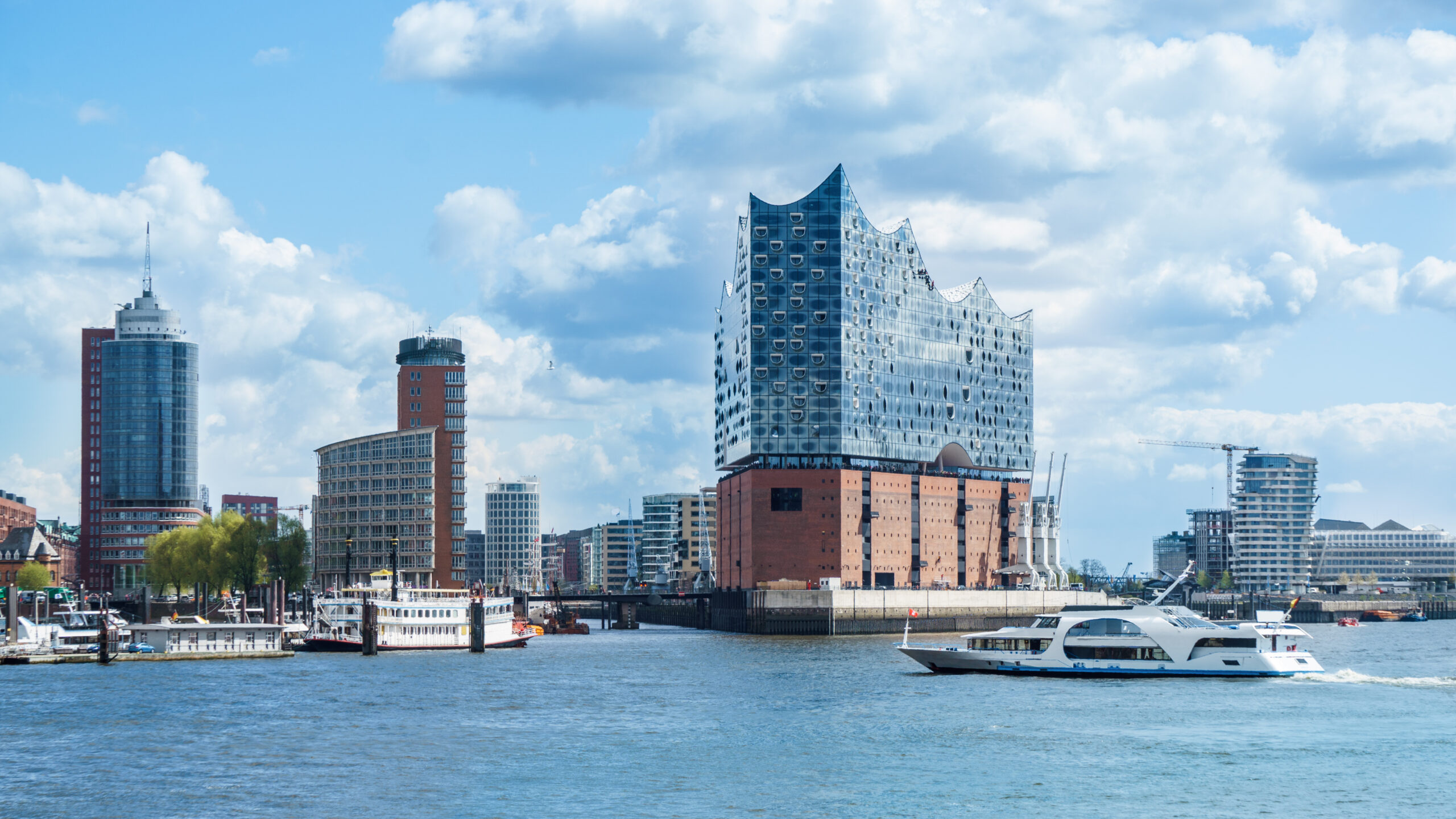
Isolation des vibrations pour maintenir l’intégrité acoustique de l’Elbphilharmonie.
Hambourg, deuxième ville d’Allemagne, a accueilli un nouveau monument en 2017. Imaginez la splendide Elbphilharmonie dans le quartier historique de Speicherstadt, un phare culturel qui s’intègre harmonieusement dans son environnement. Construite sur les fondations d’anciens docks, la structure abrite non seulement des salles de concert, mais aussi des espaces publics, des hôtels et des espaces de vie, incarnant ainsi les nombreuses fonctions qui peuvent être créées ensemble.
La conception de l’Elbphilharmonie ne visait pas seulement l’excellence architecturale, mais aussi la transcendance acoustique, la création de salles de concert qui se dressent comme des forteresses contre les perturbations et les interférences sonores, tant à l’intérieur qu’à l’extérieur de l’édifice. La mission était claire, mais le défi était de taille : concevoir des salles de concert exemptes de vibrations, de bruits solidiens et des échos du port, tout en veillant à ce que la sérénité des espaces environnants ne soit pas affectée par les concerts symphoniques qui s’y déroulent.

Défi
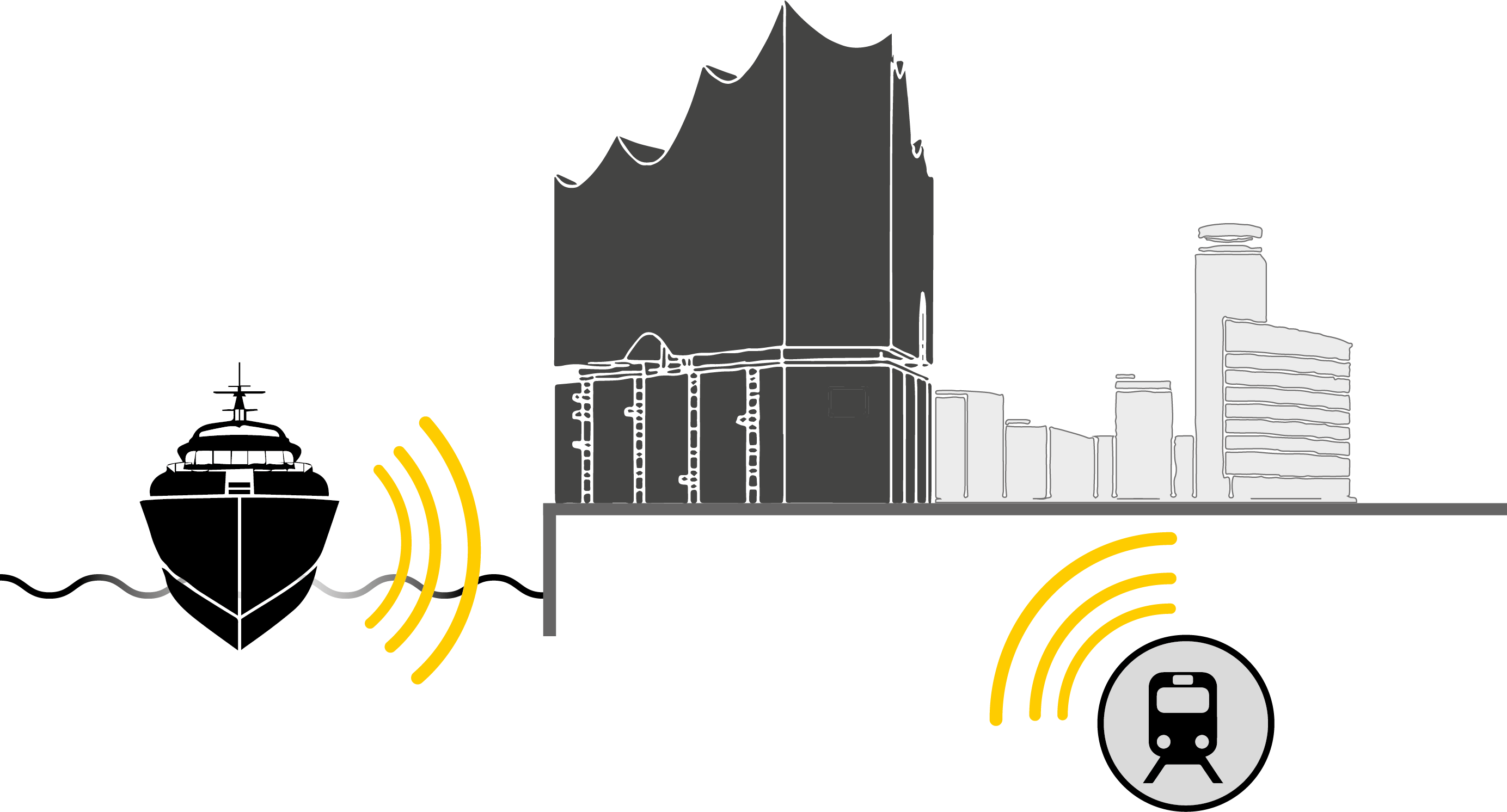
La pièce maîtresse de ce projet est la grande salle de concert, dirigée par le célèbre maestro de l’acoustique Yasuhisa Toyota. Le défi n’était pas seulement la courbure des murs, mais également l’art de restituer parfaitement la musique classique. Les salles de concert devaient être protégées des vibrations basses fréquences émanant des klaxons des navires voisins, des bruits d’impact de l’environnement maritime et de l’intrusion potentielle des bruits solidiens.
En même temps, cette intention allait au-delà des salles de concert ; elle englobait également l’harmonie des espaces environnants, où le calme et la tranquillité sont souhaités pendant les représentations. L’hôtel et les espaces de vie adjacents devaient être protégés de la musique symphonique provenant des salles de concert.
GERB a été consulté en 2005 pour relever ces défis acoustiques complexes. En tant que spécialiste de l’isolation vibratoire, nous avons eu l’honneur de développer une solution qui combine les différentes exigences en un seul système.
Solution
Afin d’obtenir un découplage minutieux des salles de concert, nous avons contribué au calcul de la construction de la coque en acier, nervure par nervure. La charge totale par nervure a été distribuée aux boites à ressorts GERB en conséquence.
Une brillante stratégie architecturale a été appliquée lors de la conception des deux salles de concert en tant qu’unités indépendantes au sein de l’Elbphilharmonie. Les salles se dressent comme des îles, reliées à la structure principale par un réseau de 362 boites à ressorts hélicoïdaux en acier pour la grande salle et de 56 boites pour la salle de récital. Ces boites à ressorts sont plus que de simples connecteurs : elles forment une barrière résistante contre le passage des vibrations et des bruits solidiens. Cette approche innovante, souvent appelée solution « boîte dans la boîte », crée un havre d’harmonie où le son et le silence coexistent. Cette approche boîte dans la boîte est l’incarnation de l’expertise de GERB. Les salles ne sont pas simplement construites, elles sont enveloppées dans une étreinte dynamique d’isolation.
Ces assemblages de ressorts, mélange d’élasticité et de stabilité, ont été soigneusement calibrés pour assurer leur double rôle. Leur élasticité, une caractéristique essentielle, assure une isolation optimale, protégeant les salles des perturbations extérieures. La stabilité, quant à elle, est une garantie contre tout déplacement injustifié de la position des salles, même en cas de changement de charge ou d’autres circonstances.
Données techniques:
Structure: Boite dans la boite
Source vibratoire: Bruits solidiens de l’environnement
Charge: Grande salle : 90 000 kN, Salle de récital : 20 000 kN
Isolation: 418 boites à ressorts précontraintes GP
Fréquence propre: Grande salle : 4,5 Hz, Salle de récital : 3,5 Hz
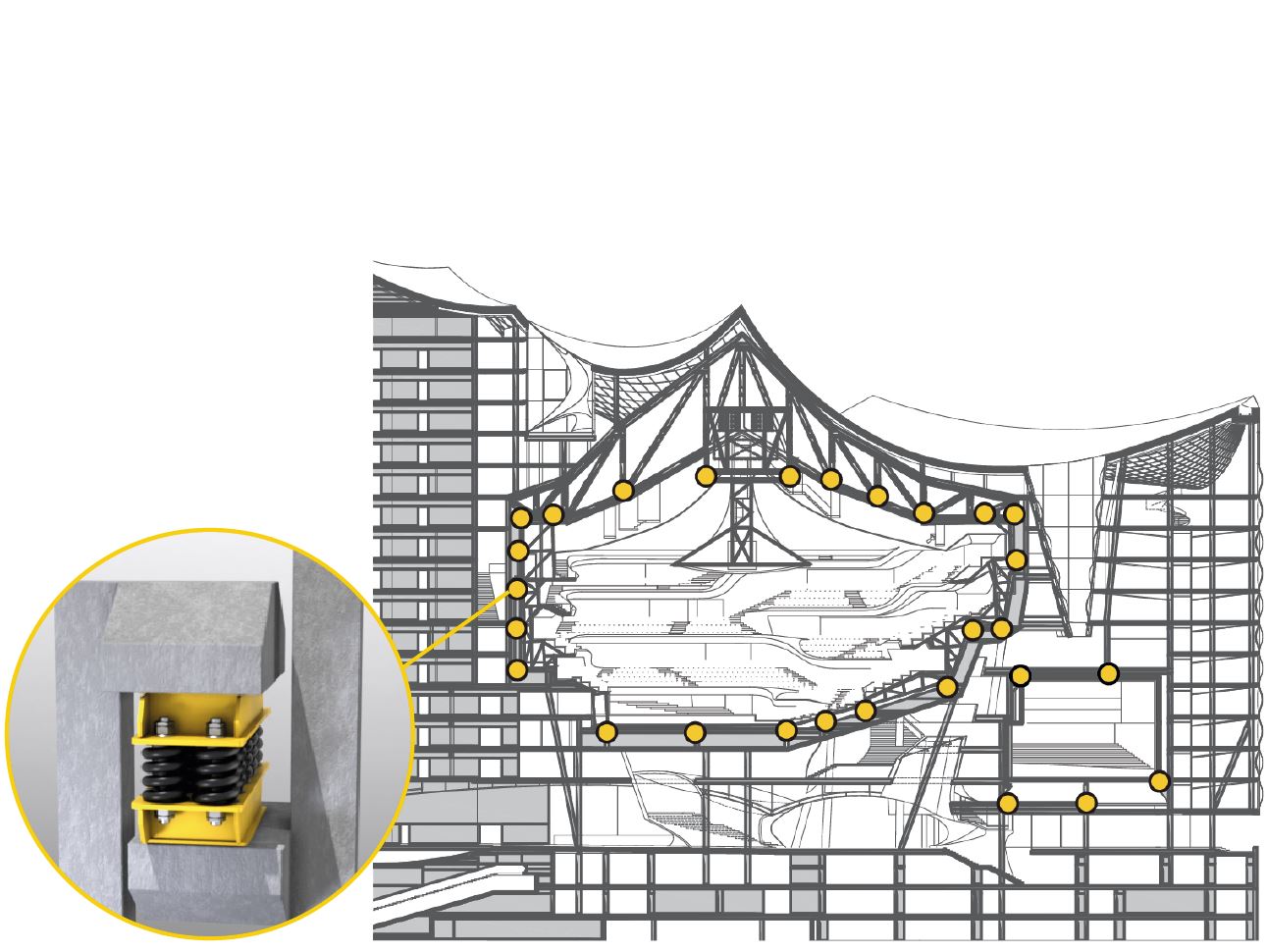
Mise en œuvre
En quête d’intimité, la question de savoir comment donner au public le sentiment d’être proche des artistes est devenue le point le plus important du travail de conception acoustique. La salle a été conçue selon la configuration dite « en vignoble », qui place le public aussi près que possible de la scène. Pour parvenir à l’intimité acoustique, la solution envisagée consistait à créer de petits groupes de sièges pour le public et à concevoir des surfaces murales réfléchissant le son pour chaque groupe de sièges.
Que ce soit lors des premières répétitions avec seulement quelques invités, ou en configuration de salle pleine, il a été confirmé que l’expérience sonore était exceptionelle et rendue possible dans ce bâtiment grâce à une isolation très performante des vibrations et des bruits solidiens, et ce dans chacune des deux salles. La salle de récital et la grande salle de concert flottent à l’intérieur du bâtiment principal de l’Elbphilharmonie et sont complètement découplées sur le plan acoustique – aucun bruit de structure ne pénètre ou ne s’échappe des boites à ressorts hélicoïdaux en acier. Le défi consistant à combiner des salles de concert exigeantes sur le plan acoustique avec des utilisations urbaines et des espaces publics dans un seul bâtiment a été relevé et mis en œuvre avec succès. Aujourd’hui, des artistes et des orchestres de renommée mondiale se produisent dans l’Elbphilharmonie, l’une des meilleures salles de concert au monde.

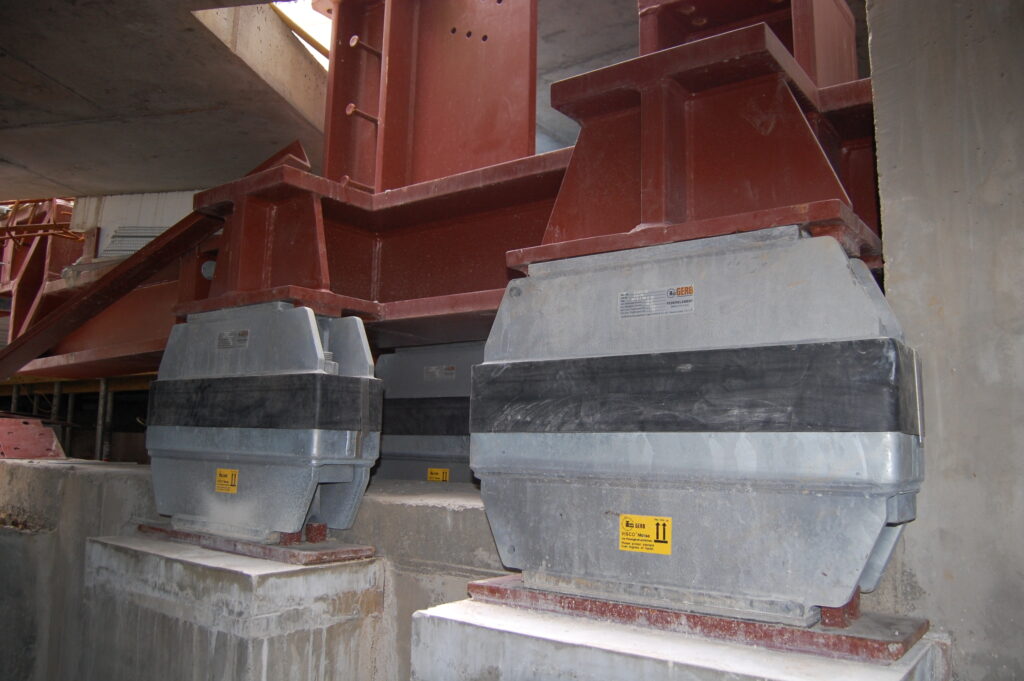
Ressources supplémentaires
Vous souhaitez de plus amples informations à ce sujet ?
N'hésitez pas à nous contacter et à nous poser vos questions personnelles.
L'un de nos ingénieurs du projet vous répondra dans les plus brefs délais.
Protection de l’Elbphilharmonie vis-à-vis des transmissions acoustiques et des bruits solidiens
Isolation des vibrations pour maintenir l’intégrité acoustique de l’Elbphilharmonie.

Hambourg, deuxième ville d’Allemagne, a accueilli un nouveau monument en 2017. Imaginez la splendide Elbphilharmonie dans le quartier historique de Speicherstadt, un phare culturel qui s’intègre harmonieusement dans son environnement. Construite sur les fondations d’anciens docks, la structure abrite non seulement des salles de concert, mais aussi des espaces publics, des hôtels et des espaces de vie, incarnant ainsi les nombreuses fonctions qui peuvent être créées ensemble.
La conception de l’Elbphilharmonie ne visait pas seulement l’excellence architecturale, mais aussi la transcendance acoustique, la création de salles de concert qui se dressent comme des forteresses contre les perturbations et les interférences sonores, tant à l’intérieur qu’à l’extérieur de l’édifice. La mission était claire, mais le défi était de taille : concevoir des salles de concert exemptes de vibrations, de bruits solidiens et des échos du port, tout en veillant à ce que la sérénité des espaces environnants ne soit pas affectée par les concerts symphoniques qui s’y déroulent.
Protection de l’Elbphilharmonie vis-à-vis des transmissions acoustiques et des bruits solidiens
Isolation des vibrations pour maintenir l’intégrité acoustique de l’Elbphilharmonie. Hambourg, deuxième ville d’Allemagne, a accueilli un nouveau monument en 2017.
Imaginez la splendide Elbphilharmonie dans le quartier historique de Speicherstadt, un phare culturel qui s’intègre harmonieusement dans son environnement. Construite sur les fondations d’anciens docks, la structure abrite non seulement des salles de concert, mais aussi des espaces publics, des hôtels et des espaces de vie, incarnant ainsi les nombreuses fonctions qui peuvent être créées ensemble.
La conception de l’Elbphilharmonie ne visait pas seulement l’excellence architecturale, mais aussi la transcendance acoustique, la création de salles de concert qui se dressent comme des forteresses contre les perturbations et les interférences sonores, tant à l’intérieur qu’à l’extérieur de l’édifice. La mission était claire, mais le défi était de taille : concevoir des salles de concert exemptes de vibrations, de bruits solidiens et des échos du port, tout en veillant à ce que la sérénité des espaces environnants ne soit pas affectée par les concerts symphoniques qui s’y déroulent.

Défi
La pièce maîtresse de ce projet est la grande salle de concert, dirigée par le célèbre maestro de l’acoustique Yasuhisa Toyota. Le défi n’était pas seulement la courbure des murs, mais également l’art de restituer parfaitement la musique classique. Les salles de concert devaient être protégées des vibrations basses fréquences émanant des klaxons des navires voisins, des bruits d’impact de l’environnement maritime et de l’intrusion potentielle des bruits solidiens.
En même temps, cette intention allait au-delà des salles de concert ; elle englobait également l’harmonie des espaces environnants, où le calme et la tranquillité sont souhaités pendant les représentations. L’hôtel et les espaces de vie adjacents devaient être protégés de la musique symphonique provenant des salles de concert.


Solution
Données techniques:
Structure: Boite dans la boite
Source vibratoire: Bruits solidiens de l’environnement
Charge: Grande salle : 90 000 kN, Salle de récital : 20 000 kN
Isolation: 418 boites à ressorts précontraintes GP
Fréquence propre: Grande salle : 4,5 Hz, Salle de récital : 3,5 Hz

Afin d’obtenir un découplage minutieux des salles de concert, nous avons contribué au calcul de la construction de la coque en acier, nervure par nervure. La charge totale par nervure a été distribuée aux boites à ressorts GERB en conséquence.
Une brillante stratégie architecturale a été appliquée lors de la conception des deux salles de concert en tant qu’unités indépendantes au sein de l’Elbphilharmonie. Les salles se dressent comme des îles, reliées à la structure principale par un réseau de 362 boites à ressorts hélicoïdaux en acier pour la grande salle et de 56 boites pour la salle de récital. Ces boites à ressort sont plus que de simples connecteurs : elles forment une barrière résistante contre le passage des vibrations et des bruits solidiens. Cette approche innovante, souvent appelée solution « boîte dans la boîte », crée un havre d’harmonie où le son et le silence coexistent. Cette approche » boîte dans la boîte » est l’incarnation de l’expertise de GERB. Les salles ne sont pas simplement construites, elles sont enveloppées dans une étreinte dynamique d’isolation.
Ces assemblages de ressorts, mélange d’élasticité et de stabilité, ont été soigneusement calibrés pour assurer leur double rôle. Leur élasticité, une caractéristique essentielle, assure une isolation optimale, protégeant les salles des perturbations extérieures. La stabilité, quant à elle, est une garantie contre tout déplacement injustifié de la position des salles, même en cas de changement de charge ou d’autres circonstances.
Défi
La pièce maîtresse de ce projet est la grande salle de concert, dirigée par le célèbre maestro de l’acoustique Yasuhisa Toyota. Le défi n’était pas seulement la courbure des murs, mais également l’art de restituer parfaitement la musique classique. Les salles de concert devaient être protégées des vibrations basses fréquences émanant des klaxons des navires voisins, des bruits d’impact de l’environnement maritime et de l’intrusion potentielle des bruits solidiens.
En même temps, cette intention allait au-delà des salles de concert ; elle englobait également l’harmonie des espaces environnants, où le calme et la tranquillité sont souhaités pendant les représentations. L’hôtel et les espaces de vie adjacents devaient être protégés de la musique symphonique provenant des salles de concert.


Solution
Afin d’obtenir un découplage minutieux des salles de concert, nous avons contribué au calcul de la construction de la coque en acier, nervure par nervure. La charge totale par nervure a été distribuée aux boites à ressorts GERB en conséquence.
Une brillante stratégie architecturale a été appliquée lors de la conception des deux salles de concert en tant qu’unités indépendantes au sein de l’Elbphilharmonie. Les salles se dressent comme des îles, reliées à la structure principale par un réseau de 362 boites à ressorts hélicoïdaux en acier pour la grande salle et de 56 boites pour la salle de récital. Ces boites à ressorts sont plus que de simples connecteurs : elles forment une barrière résistante contre le passage des vibrations et des bruits solidiens. Cette approche innovante, souvent appelée solution boîte dans la boîte, crée un havre d’harmonie où le son et le silence coexistent. Cette approche boîte dans la boîte est l’incarnation de l’expertise de GERB. Les salles ne sont pas simplement construites, elles sont enveloppées dans une étreinte dynamique d’isolation.
Ces assemblages de ressorts, mélange d’élasticité et de stabilité, ont été soigneusement calibrés pour assurer leur double rôle. Leur élasticité, une caractéristique essentielle, assure une isolation optimale, protégeant les salles des perturbations extérieures. La stabilité, quant à elle, est une garantie contre tout déplacement injustifié de la position des salles, même en cas de changement de charge ou d’autres circonstances.
Données techniques:
Structure: Boite dans la boite
Source vibratoire: Bruits solidiens de l’environnement
Charge: Grande salle : 90 000 kN, Salle de récital : 20 000 kN
Isolation: 418 boites à ressorts précontraintes GP
Fréquence propre: Grande salle : 4,5 Hz, Salle de récital : 3,5 Hz

Mise en œuvre


En quête d’intimité, la question de savoir comment donner au public le sentiment d’être proche des artistes est devenue le point le plus important du travail de conception acoustique. La salle a été conçue selon la configuration dite « en vignoble », qui place le public aussi près que possible de la scène. Pour parvenir à l’intimité acoustique, la solution envisagée consistait à créer de petits groupes de sièges pour le public et à concevoir des surfaces murales réfléchissant le son pour chaque groupe de sièges.
Que ce soit lors des premières répétitions avec seulement quelques invités, ou en configuration de salle pleine, il a été confirmé que l’expérience sonore était exceptionelle et rendue possible dans ce bâtiment grâce à une isolation très performante des vibrations et des bruits solidiens, et ce dans chacune des deux salles. La salle de récital et la grande salle de concert flottent à l’intérieur du bâtiment principal de l’Elbphilharmonie et sont complètement découplées sur le plan acoustique – aucun bruit de structure ne pénètre ou ne s’échappe des boites à ressorts hélicoïdaux en acier. Le défi consistant à combiner des salles de concert exigeantes sur le plan acoustique avec des utilisations urbaines et des espaces publics dans un seul bâtiment a été relevé et mis en œuvre avec succès. Aujourd’hui, des artistes et des orchestres de renommée mondiale se produisent dans l’Elbphilharmonie, l’une des meilleures salles de concert au monde.
Mise en œuvre
En quête d’intimité, la question de savoir comment donner au public le sentiment d’être proche des artistes est devenue le point le plus important du travail de conception acoustique. La salle a été conçue selon la configuration dite « en vignoble », qui place le public aussi près que possible de la scène. Pour parvenir à l’intimité acoustique, la solution envisagée consistait à créer de petits groupes de sièges pour le public et à concevoir des surfaces murales réfléchissant le son pour chaque groupe de sièges.
Que ce soit lors des premières répétitions avec seulement quelques invités, ou en configuration de salle pleine, il a été confirmé que l’expérience sonore était exceptionelle et rendue possible dans ce bâtiment grâce à une isolation très performante des vibrations et des bruits solidiens, et ce dans chacune des deux salles. La salle de récital et la grande salle de concert flottent à l’intérieur du bâtiment principal de l’Elbphilharmonie et sont complètement découplées sur le plan acoustique – aucun bruit de structure ne pénètre ou ne s’échappe des boites à ressorts hélicoïdaux en acier. Le défi consistant à combiner des salles de concert exigeantes sur le plan acoustique avec des utilisations urbaines et des espaces publics dans un seul bâtiment a été relevé et mis en œuvre avec succès. Aujourd’hui, des artistes et des orchestres de renommée mondiale se produisent dans l’Elbphilharmonie, l’une des meilleures salles de concert au monde.
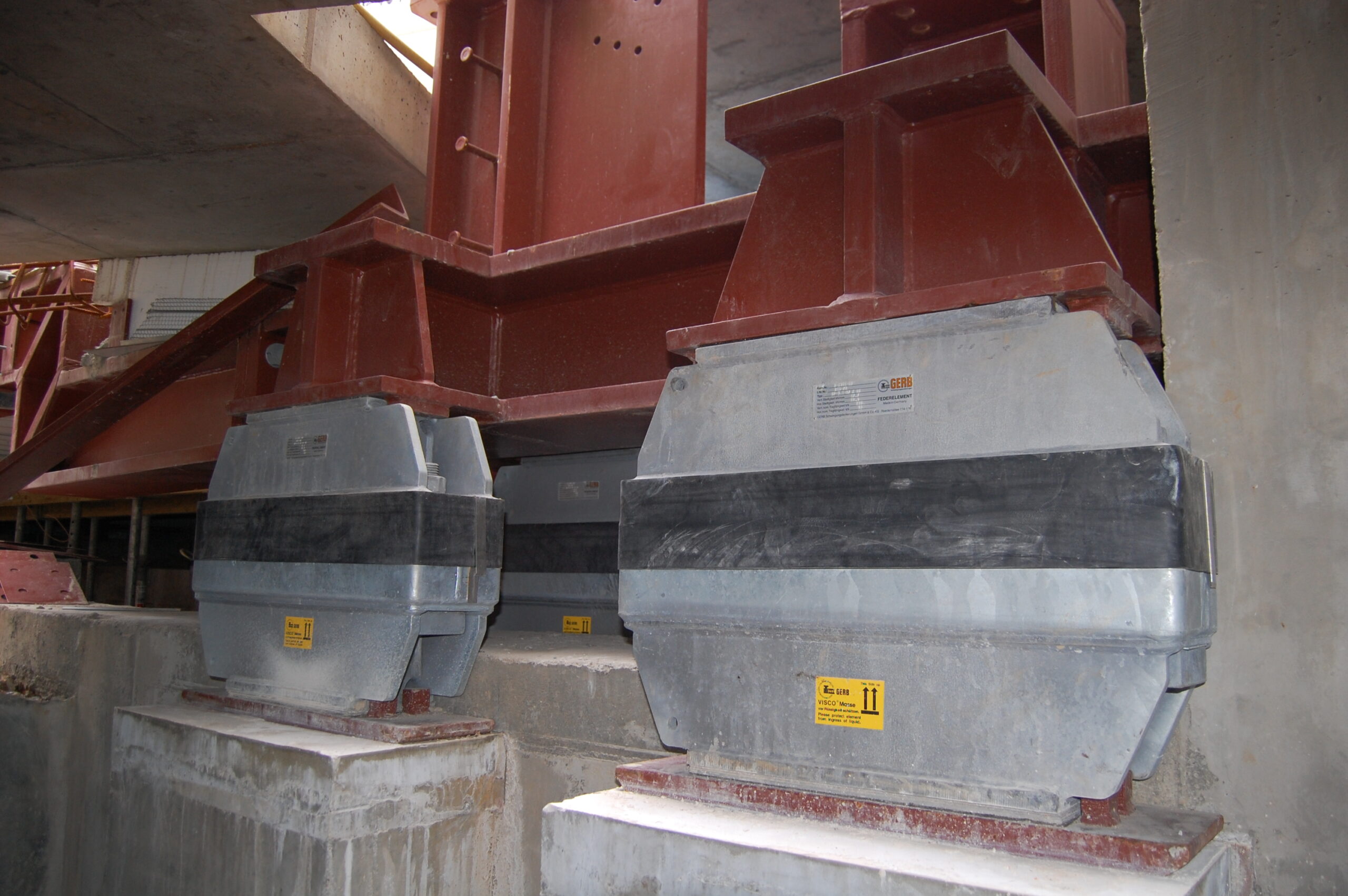

Partager cet article
Ressources supplémentaires
Vous souhaitez de plus amples informations à ce sujet ?
N'hésitez pas à nous contacter et à nous poser vos questions personnelles.
L'un de nos ingénieurs du projet vous répondra dans les plus brefs délais.
Ressources supplémentaires
Vous souhaitez de plus amples informations à ce sujet ?
N'hésitez pas à nous contacter et à nous poser vos questions personnelles.
L'un de nos ingénieurs du projet vous répondra dans les plus brefs délais.